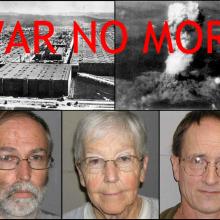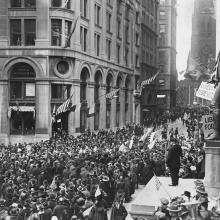hiroshima
Both films are sympathetic to creators, but neither film lets their creations off the hook. Oppenheimer worries aloud how the nuclear power he unleashed will shape the atomic age. Barbie faces a lunch table of schoolgirls who tell her exactly how the Barbie beauty standards made them feel un-feminine. But both films ultimately move beyond the myth of the single creator and focus on the forces that shape that creation’s ongoing impact on the larger world.
IN NOVEMBER, a stray missile from the Russia-Ukraine war landed in Poland, killing two men in their 60s who worked at a grain warehouse. It took several emergency meetings with NATO officials to determine whether Russia had intentionally escalated the war into the region of the Western military alliance. All parties deemed it an “accident.” (The missile came from Ukraine.)
What if that stray missile had a nuclear warhead?
Russian President Vladimir Putin’s threat to use nuclear weapons in Ukraine must be firmly condemned, as well as his cruel and illegal war with its continued escalation. But accidents happen. Even a limited or regional use of nuclear weapons could have planetary effects, blocking the sun enough to cause a global temperature drop, collapsing crop production, and resulting in massive starvation, according to a report by the International Physicians for the Prevention of Nuclear War.
As the Poland example shows, today we are facing the most serious nuclear threats since the Cuban missile crisis 60 years ago, which then-Secretary of Defense Robert McNamara said we survived only by luck.
Nuclear weapons raise biblical issues. The continuing survival of God’s creation and the human race cannot rely on just “luck” but instead needs providential intervention. A few weeks before the November missile crisis in Poland, Pope Francis said, “Today, in fact, something we dreaded and hoped never to hear of again is threatened outright: the use of atomic weapons, which even after Hiroshima and Nagasaki continued wrongly to be produced and tested.”
THIS MONTH WE HEAR ABOUT God’s alluring wisdom, personified as the ultimate hostess, who invites us to a banquet in her glorious home with its seven pillars. The passage from Proverbs 9 always reminds me of an unforgettable moment in Lawrence of Arabia’s Seven Pillars of Wisdom. Once when he was in the desert, taking water from a spring, Lawrence saw coming toward him “a grey-bearded, ragged man, with a hewn face of great power and weariness.” When this man drew near the spring, he shut his eyes and then groaned aloud, “The love is from God; and of God; and toward God.”
This pronouncement would be a perfect summation of the “mystical core of the gospel,” worth holding in our hearts as we hear about Jesus as the bread that comes down from heaven and gives life to the world. Other scriptures will speak of the endemic folly that disconnects people from this love, of the new patterns of behavior that stem from embracing the saving love of God that reaches into our predicament to liberate us through Christ. It can remind us that the complaining pitilessly recorded in the Exodus narratives and the hostile reception to Jesus’ claim to be the authentic food and drink from God really stem from our fear of true intimacy with God, fear of becoming caught up in the love that is of God and returns to God with and in Christ.
[ August 5 ]
A Satanic Cloud
Exodus 16:2-4, 9-15; Psalm 78:23-29; Ephesian 4:1-6; John 6:24-35
THE TENDENCY OF churches to make our worship “lite” in the summer becomes harder to justify this Sunday. We worship under the cloud of the anniversary of the U.S. bombing of Hiroshima, Japan, on Aug. 6, 1945, the horror that ushered in our nuclear age. We have gotten used to our “sane” leaders coolly considering the conditions in which they would unleash weapons that could make our—God’s—earth uninhabitable. Ours is a self-imposed wilderness exile in which, for those who are brave enough to look up, this lurid, satanic pillar of cloud by day and pillar of fire by night continually looms ahead, drawing us toward self-destruction.
Ten days before Donald Trump's inauguration, the former mayor of Hiroshima sent the president-elect a letter calling on the incoming U.S. administration to lead on nuclear non-use in Northeast Asia.
"Keenly aware that your decisions on matters related to nuclear weapons will affect everybody in the world and especially those of us living in Hiroshima, we, Hiroshima citizens and hibakusha (A-bomb survivors), expect these decisions to be wise and peaceable," Tadatoshi Akiba, Hiroshima's former mayor, wrote.

Image via timquo/Shutterstock.com
We should have no fear of making an apology, which is the outward symbol of an inward change of heart acknowledging and renouncing our violence. We should apologize not only in Hiroshima, but in Nagasaki, Vietnam, Fallujah, Kunduz — around the world, and upon our own shores, with reparations to Native and African Americans.
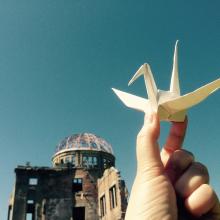
Image via chuugo/Shutterstock.com
Confessing our own violence would not deny violence committed against us. Rather, an apology could call attention to war atrocities of the past and present on all sides. Admitting that the deadliest bombings in history had selfish strategic motivations, admitting that life was so thoroughly devalued and destroyed for no greater good (as if a greater good could exist) could force people on all sides to rethink the “necessities” of other wars past and present. Debunking one war lie could lead to the debunking of many war lies. And governments built on violence, powers upheld and strengthened by the looming threat of death, seek to extinguish the light of truth.
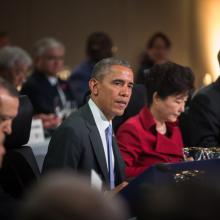
Image via Drop of Light / Shutterstock.com
The White House announced May 10 that President Obama will travel to Hiroshima, Japan, reports The New York Times.
This will be the first time a sitting U.S. president has visited the city where the U.S. dropped an atomic bomb at the end of World War II.

Pope Francis waves as he leads the Angelus prayer from the window of the Apostolic Palace in St. Peter’s Square at the Vatican August 9, 2015. Photo courtesy REUTERS / Tony Gentile / RNS
Seventy years after the U.S. dropped an atomic bomb on the Japanese city of Nagasaki, Pope Francis on Aug. 9 described the bomb as a “lasting warning to humanity.”
Speaking to the faithful gathered in St. Peter’s Square, Francis recalled the “horror and repulsion” aroused by the twin bombings of Nagasaki on Aug. 9 1945, and Hiroshima, three days earlier.
“This (event) has become the symbol of mankind’s enormous destructive power when it makes a distorted use of scientific and technical progress,” he said.
1. WATCH: Jon Stewart and ‘The Daily Show:’ 9 Essential Moments
The New York Times offers this great video retrospective from 16 years of Jon Stewart nailing it four nights a week. He will be missed. #JonVoyage
2. The Women of the Protest Line
Almost a year after Michael Brown’s death, Amy Pedersen writes on how the movement in Ferguson, Mo., and beyond is largely a movement of women. “When you watch this weekend from afar, know that you are watching the movement of women; that we are on the street because that is where God is moving. … We are women and because we are women, we know how to be brave.”
3. A Haunting Timelapse of the 2,058 Nuclear Detonations from 1945 to 1998
This week marks the 70th anniversary of the nuclear bombings of Hiroshima and Nagasaki, ushering in the Nuclear Age. Popular Mechanics provides this arresting visual of detonations since then. Note: Keep an eye on the tickers for Russia and the U.S.

Hiroshima, Japan after the atomic bomb was dropped. Everett Historical / Shutterstock.com
The destruction of Hiroshima and Nagasaki, by any civilized standards, represented one of the moral low-points in human history. After all, by very conservative estimates, 135,000 people died from the atomic blasts—most of them civilians, the victims of the intentional targeting of cities. Think about that—these weren’t military targets, but cities full of men, women, and children, going about their lives, destroyed in seconds by the most destructive weapons ever invented.
But the point of memorializing isn’t about the past. It’s about ensuring such things happen “never again.”

natrot / Shutterstock
Like many of my millennial peers, I was barely in diapers when the Cold War ended, never practiced fallout drills in school, and only recently learned what those yellow-and-black signs on old buildings meant. As a kid, if I thought about nukes at all, it was in a passive tense, World War II-history sort of way. In other words: not my problem.
But as we mark the 70th anniversary of Hiroshima and Nagasaki — when U.S. aircrafts dropped bombs on two Japanese cities, killing 135,000 people, by conservative estimates — I spent some time in the Sojourners archives trying to fill the gaps in my nuclear education. Here’s what I found.
As we mark the 70th anniversary of the atomic bombings of Hiroshima and Nagasaki, the world waits to see if the Iran deal will come to fruition and thus avoid war. Once again, the debate about nuclear weapons appears at the forefront. At the same time, inside the U.S., the #BlackLivesMatter movement continues to make clear it will no longer be politics as usual as activists organize, protest, and fight every day to destroy institutional racism. However, it is no coincidence that these events are all happening simultaneously as they have always been and continue to be inextricably linked.
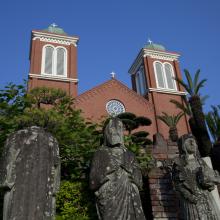
KPG_Payless / Shutterstock
OVER THE LAST 14 months, I visited Nagasaki six times to prepare for and then participate in the Christian Forum for Reconciliation in Northeast Asia, along with 60 Christian leaders from Japan, the U.S., China, and South and North Korea.
Following the forum, I attended the International Symposium for Peacemaking in Northeast Asia, held at the Nagasaki Atomic Bomb Museum. These events gave me much opportunity to think about nuclear weapons and peacemaking, alone and together with a peaceable community of believers.
The devastating power unleashed on Nagasaki and Hiroshima 70 years ago shocked the human community. I have friends whose families suffered when atomic bombs fell on those two Japanese cities. But Japan was not simply a victim. The Pacific War started with the bombing of Pearl Harbor. And if the Japanese military had then had an atomic bomb, I am quite certain they would have used it.
Today, many are working to abolish nuclear weapons as inhumane and unacceptable. I am convinced that nuclear weapons cannot be justified. But the question “Why should we abolish nuclear weapons?” leads to additional questions: How do we think about wars, about killing and violence, in general? While seeking to abolish nuclear weapons, should we keep on making, selling, and using other kinds of weapons?

Svjatogor / Shutterstock
My new friends adhered to the “seamless garment” philosophy, also called the consistent life ethic, one committed to the protection of all human life, whether from war, poverty, racism, capital punishment, euthanasia, or abortion. One of them gave me a button that read “Peace begins in the womb,” and I pinned it to the bottom of the black leather motorcycle jacket I used to wear in those days.
IMAGINE IF YOU will a world in which the most destructive weapons were “conventional” explosives. These bombs, often with nicknames such as “Daisy Cutter” or “bunker buster” or even the “Mother of All Bombs,” have enormous power: The Vietnam-era Daisy Cutter, one of the largest conventional weapons ever used, was designed to flatten a forest into a helicopter landing zone with a blast equal to about 15,000 pounds of TNT.
Now imagine that someone says, “Those conventional bombs aren’t destructive enough. Let’s invent a weapon a million times more powerful, one that releases radiation that magnifies the killing effects for generations. And let’s make 16,000 of those weapons.”
A sane world would respond, “You’ve gotta be kidding.”
But in the real world, it’s no joke.
Today, 70 years after the attacks on Hiroshima and Nagasaki in 1945, the world has 16,400 nuclear weapons—93 percent of them in the arsenals of the U.S. and Russia. The first H-bomb had the force of around 10 million tons of TNT, more than a million times as powerful as the worst conventional weapons.
ONE DAY, WHEN I was a student at Christ the King Elementary School in my hometown of Richland, Wash., the nuns gathered all the kids, two by two, and walked us outside to the parking lot. There sat a mobile van emblazoned with the logo of the Atomic Energy Commission and the words “Whole Body Scanner.”
One at a time, we were led into the van, where we laid on a white-sheathed table beneath a large, (scary), medical-looking machine. There was a whirring sound, and after a minute or two we were told to get up and make room for the next child. We weren’t told what the process was for, but it’s safe to assume that the government was interested in the effects of radiation on those of us who were “downwinders” from one of the nation’s largest nuclear complexes.
Richland was (and is) the bedroom community for the Hanford Nuclear Reservation. Hanford was built in the 1940s as part of the Manhattan Project, the massive wartime program that led to the atomic bombs dropped on Hiroshima and Nagasaki at the end of World War II. Hanford’s role was the production of plutonium for the world’s first nuclear weapon, the “test” bomb detonated in New Mexico a few weeks before Hiroshima, and for the bomb that destroyed Nagasaki three days later.
Those weapons were dropped 69 years ago, but the debate about their morality continues. It emerged again this spring when the two Missouri senators proposed renaming D.C.’s Union Station after Harry S. Truman, who authorized history’s only nuclear attack on people. One commenter in a related discussion wrote, “I have a problem with judging past cultures by today's standards. To end WWII we dropped bombs on cities filled with innocent civilians. By today's standards that would be condemned. Are you willing to say we should not have done that to end WWII?”
I just arrived in Tennessee for a little sabbatical in the hills where I grew up. As I settled into my old childhood room again for a week or so of rest, I noticed a pile of newspaper articles my mom placed by the toilet. She's gotten into the habit of putting clippings of articles there that she thinks I'll enjoy reading while having my special time in the bathroom.
One of the articles was an extraordinary front-page story in the Knoxville News Sentinel about three peace activists who shut down the Y-12 nuclear plant last month in Oak Ridge for more than weeks.
In the predawn hours of July 28, three unarmed peace activists entered the Y-12 nuclear plant and, over a matter of hours, made their unprecedented way through the layers of security to the very heart of the facility, where they performed a prayerful service, hung "crime-scene" tape and poured human blood as a symbol of the violence of nuclear weapons. One of the intruders was an 82-year-old nun who is now an international celebrity. It's a contemporary story of David and Goliath, the shepherd boy who took on a giant with nothing but a slingshot.
The article makes a spectacle of how these three folks, whose average age was 67, managed to mosey into one of the most highly secure and potentially deadly facilities in the world. But they chose the spot for a reason.
The Oak Ridge Y-12 plant was responsible for the explosives of the Hiroshima bomb. It has been called "the Fort Knox of Uranium." The Y-12 plant is the nation's primary supplier of bomb-grade uranium, and has played a role in the manufacture of every nuclear weapon in the U.S. arsenal, which now flaunts the capacity of more than 50,000 Hiroshima-size bombs.
Sixty-seven years ago today, at 8:15 on the morning of August 6, 1945, it was a sunny morning in Hiroshima, Japan, a city of more than 300,000 people. Some were on their way to work, children were playing in the streets. Suddenly the sky exploded in a brilliant and hellish flash of light as a 15 kiloton nuclear bomb was dropped from a U.S. plane in the sky overhead. More than 70,000 people were instantly killed, some with their bodies etched into the pavement like eerie shadows. By the end of the year, as many as 140,000 had died, after five years, the toll was estimated as high as 200,000. Three days after Hiroshima, on August 9, 1945, a second nuclear bomb was used against Nagasaki, Japan. An estimated 75,000 people were killed in that explosion.
Today, according to the Associated Press, the annual ceremonies held in Hiroshima’s peace park to commemorate the bombing were attended by 50,000 people, including representatives from 70 countries. Two Americans with family ties to the bombings also attended.
Before Veteran’s Day was Veteran’s Day, it was Armistice Day.
On the 11th hour of the 11th day of the 11th month in 1918, the cessation of hostilities of World War I took effect.
It was supposed to be the end of the "war to end all wars."
In 1926, Congress passed a resolution to commemorate the day “with thanksgiving and prayer and exercises designed to perpetuate peace through good will and mutual understanding.”
In 1938 the day became known as “Armistice Day” with the intent that it would be a day dedicated to the world peace.
In 1954, after World War II, when the world stood in horror at the sight of the Nazi genocide machine and ghastly bombings of civilian populations culminating in the first ever deployment of nuclear bombs, the day became known as Veteran’s Day — a day to honor military service.
I say if we are to truly honor veterans, we ought to remember and honor Armistice Day with the hope that we can bring an end to violent conflict within and between nations.








